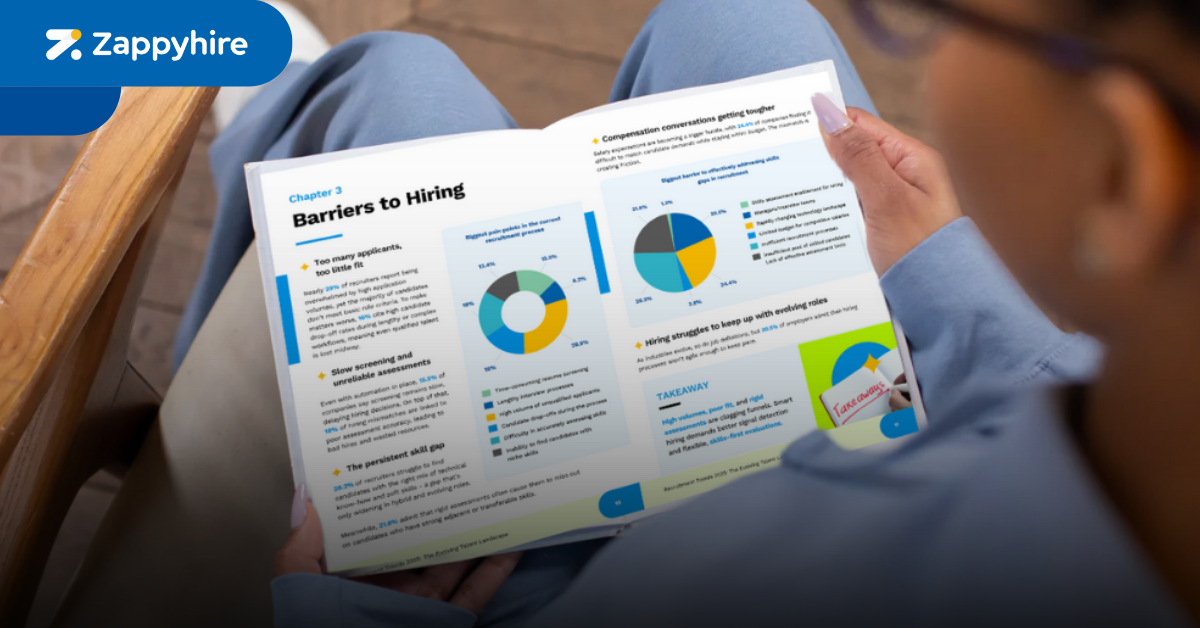
If you’re in the business of talent acquisition, you know that the recruitment process can be time-consuming and overwhelming. With so many resumes to sift through, candidates to assess, engage, and keep the rest of the stakeholders updated, it’s easy to get lost in the details. That’s where recruiting software comes in.
What is Recruiting Software?
Recruiting software is a powerful tool that helps organizations streamline and optimize their hiring process. It can automate various tasks, such as resume screening, scheduling interviews and saving time and effort. It can also help organizations find, attract, engage with, and onboard top talent, assess candidates objectively, and improve the overall candidate experience.
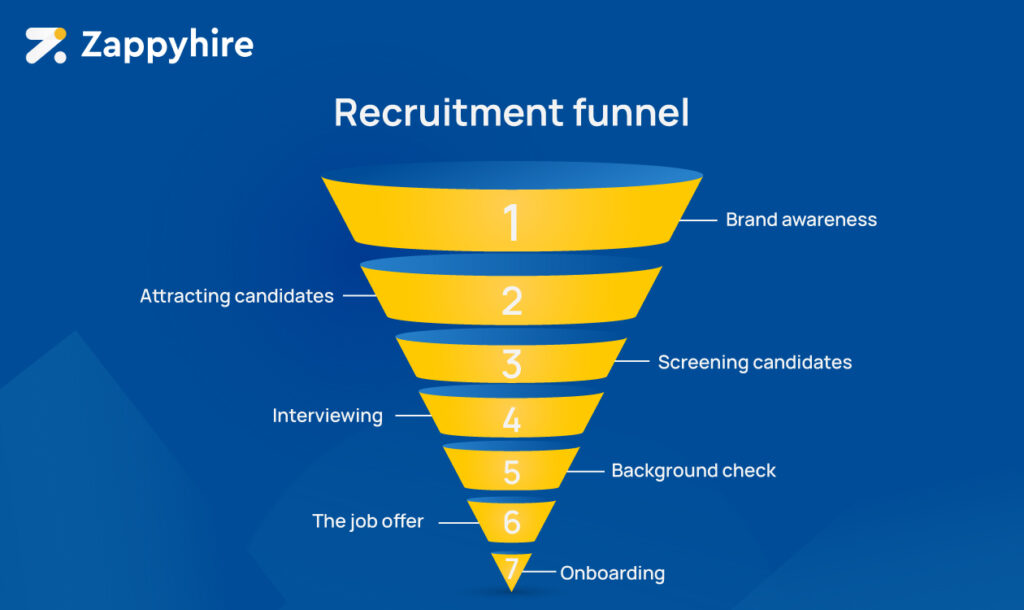
Who Uses Recruiting Software?
Human Resource Management
Human resource professionals use recruiting software to manage and organize the entire hiring process, from job postings to employee onboarding.
Recruiters / Hiring Managers
Recruiters and hiring managers can use recruiting software to find and attract top talent, as well as assess and compare candidates.
“According to a research by Capterra, 94% of recruiters and HR professionals say using recruitment software has thoroughly impacted their recruiting process.”
Source: Capterra
Recruitment Agency
Recruitment agencies can use recruiting software to manage their candidate pool and match the right candidates with the right job openings.
Small Businesses & Enterprises
Even small businesses and enterprises can benefit from using recruiting software, as it helps them find and hire top talent more efficiently, streamline the hiring process and save time and cost.
“According to Jobscan, more than 98% of Fortune 500 organizations use recruitment software for their hiring”
Source: Jobscan
7 Awesome Benefits of Using Recruitment Software
Boosts Recruiter’s Productivity
By automating tasks such as resume parsing, screening, evaluating, ranking, engaging with candidates, and scheduling interviews, recruiting software can save recruiters and hiring managers a significant amount of time, allowing them to be more productive and focus on other important tasks.
Attract & Find the Perfect Fit
Recruitment software can help you reach a wider pool of candidates through job postings on various online platforms, niche job boards, and social media. It can also use artificial intelligence to match candidates with job requirements and company culture, making it easier to find the right fit for open positions.
Objectively Assess Candidates
Assess, compare and rank candidates more efficiently and objectively using artificial intelligence to shortlist candidates based on predetermined criteria and even conduct virtual interviews using a robotic video interview or AI chatbot assistant.
Optimize Your Recruitment Efforts
Recruitment software can streamline and optimize the entire hiring process, from creating requisitions and job postings to employee onboarding. It can automate tasks such as resume screening, scheduling interviews, and even offering personalized engagement to new hires, saving time, improving efficiency, and reducing offer dropouts.
Enhance Candidate Experience
A positive candidate experience is crucial for attracting top talent. AI recruitment software can provide a seamless and efficient experience for candidates, from the initial application to the final offer. It can also keep candidates informed and engaged throughout the hiring process, improving the overall candidate experience.
Gain Valuable Insights and Data
With advanced analytics and custom reporting, recruiting software can provide valuable data and insights on your hiring process, such as the effectiveness of your job postings and the performance of your recruitment efforts. This information can help organizations optimize their hiring process and make data-driven decisions.
Diversify Your Talent Pool
By using recruiting software, organizations can make their recruiting process free of human bias and reach a more diverse pool of candidates by automating certain tasks, which can help ensure that all candidates are evaluated based on the same criteria and qualifications, rather than on factors such as their race, gender, or age.

Recruiting Software Vs ATS (Applicant Tracking System) – What is the Difference?
While recruiting software and applicant tracking systems (ATS)are similar in that they both help with the hiring process, there are some key differences.
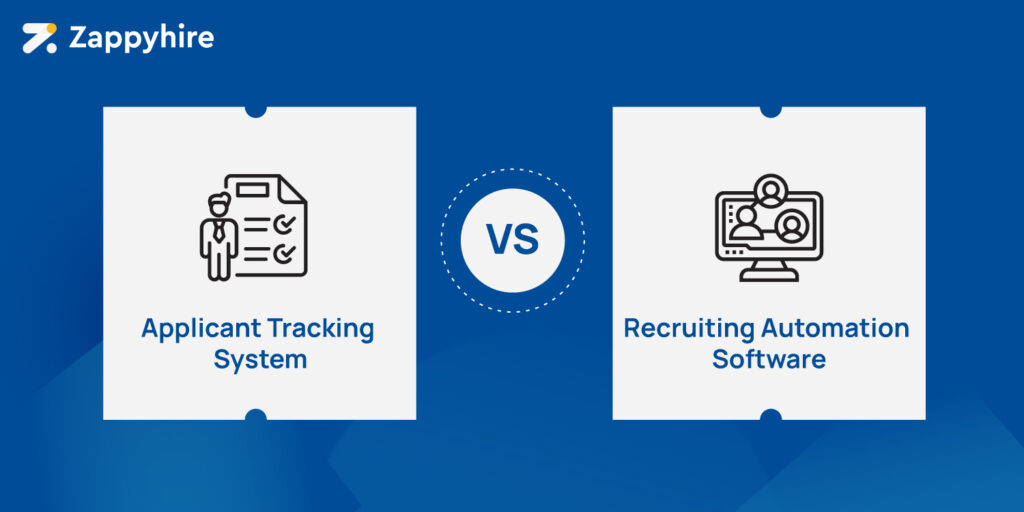
ATS is a type of software specifically designed to manage and track job applicants throughout the recruitment process.
On the other hand, recruiting software is a broader term that encompasses a variety of tools and HR technologies that help with recruiting and hiring.
Different Types of Recruiting Software
Applicant Tracking Software (ATS)
ATS helps organizations manage and track job applicants throughout the recruitment process. It can automate tasks such as resume screening, scheduling interviews, and even facilitate seamless candidate engagement. It can also provide valuable data and insights into the hiring process.
“86.1% of recruiters say using an applicant tracking system has increased the speed at which they recruit candidates.”
Source: LinkedIn
Candidate Relationship Management Software (CRM)
CRM helps recruiters and hiring managers build and maintain relationships with potential candidates. It can allow organizations to keep track of candidate information and communication, as well assend personalized emails and messagesto candidates.
“A research found that recruiters who utilize proactive CRM tools made over three times as many offers, and the offer acceptance rate was 93%”
Source: Webinar Care
AI Video Interviewing Software
This type of software helps organizations schedule and conduct virtual interviews with candidates. It can allow for video and audio communication that can be recorded, as well as screen sharing and other tools for collaboration.
Candidate Sourcing Software
This type of software helps organizations find and attract top talent by sourcing candidates from various online platforms and job boards. It can use artificial intelligence to match candidates with job requirements and company culture, making it easier for organizations to find the right fit for open positions.
Global Recruiting Software Market Size & Forecast
The global Recruitment Software market is estimated to be valued at $1.8 billion in 2020. It is expected to experience a growth rate of 6.5% annually, reaching a projected size of $2.8 billion by 2027. This growth is driven by factors such as the increasing use of technology in the hiring process, the rise of remote work, and the need for organizations to efficiently navigate the changing workforce landscape to find and hire top talent.
Innovations & Current Trends in Recruiting Software
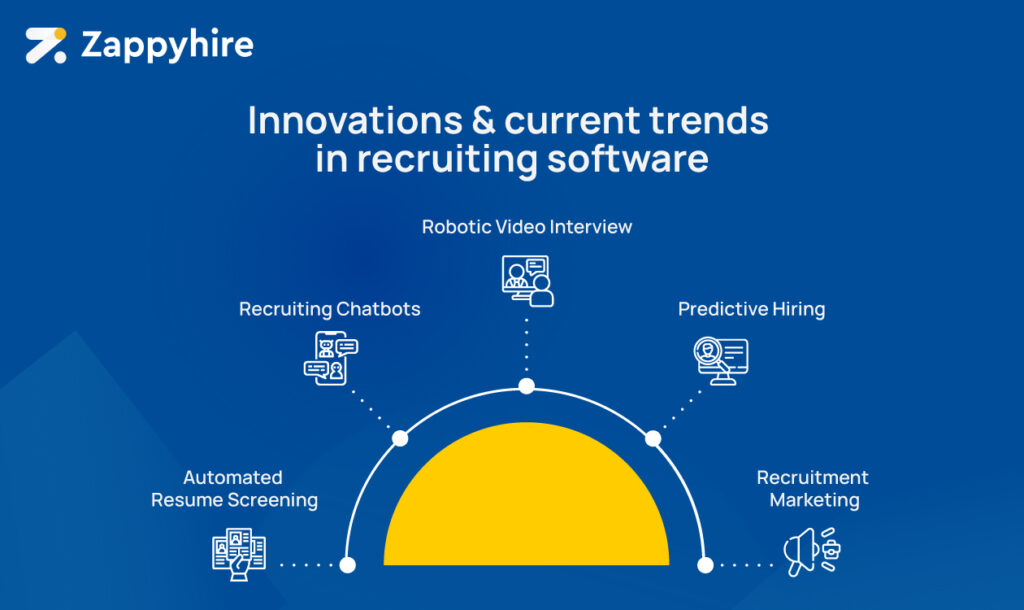
Automated Resume Screening
Some recruiting software utilizes artificial intelligence to automatically screen resumes and shortlist candidates based on predetermined criteria. This can save recruiters and hiring managers a significant amount of time and improve the efficiency of the hiring process.
Recruiting Chatbots
These virtual assistants can communicate with candidates and provide them with information about job openings and the application process. They can also answer common questions, collect documents, information, and direct candidates to the appropriate resources.
AI Robotic Video Interview
This type of software allows organizations to conduct virtual interviews with candidates using a robot or AI assistant. This allows candidates to schedule their own recorded robotic interviews and allows recruiters to watch them at their convenience. This drastically cuts down the recruitment time and eliminates the frustration of candidate no-shows. It also helps to assess the candidates efficiently.
Predictive Hiring
AI recruiting software uses machine learning algorithms to predict the success of a candidate based on their past performance and other data points. It can also create a candidate repository and recommend candidates for open positions based on previous interactions. This can help organizations make more informed hiring decisions and increase the chances of hiring top talent.
Recruitment Marketing
This helps organizations market their open positions and brand to potential candidates. It can use various tactics such as social recruiting, employer branding and a dedicated employee referral portal to reach a wider pool of active and passive candidates and attract & retain top talent.
What are the Challenges Recruiting Software Solve?
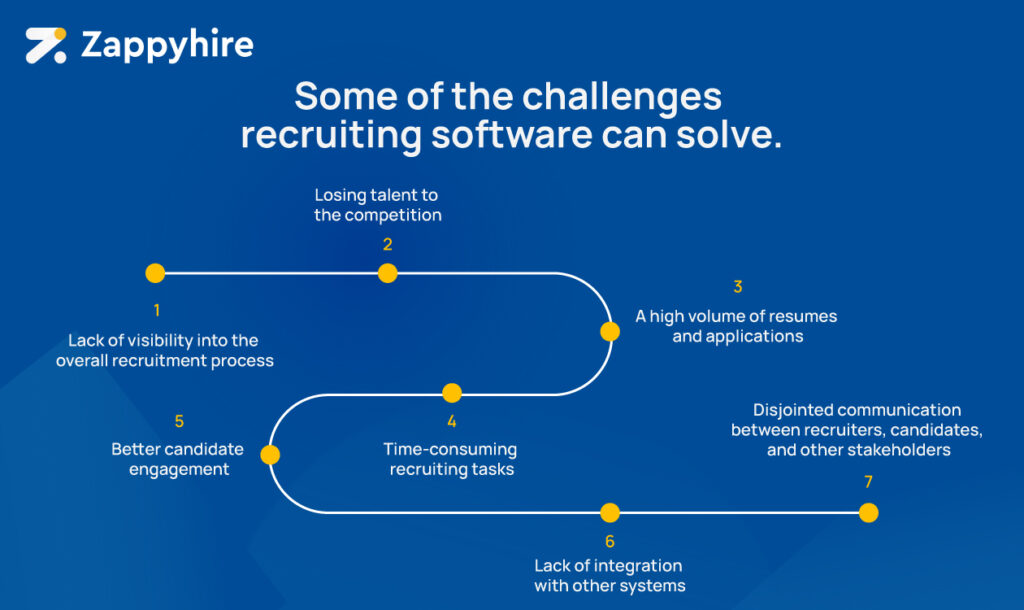
Lack of visibility into the overall recruitment process
Without a clear view of the recruitment process, it can be difficult for companies to track the status of candidates, open positions, and other important details. AI recruiting software can provide companies with greater visibility into the recruitment process by providing real-time data and insights into the progress of open positions and the status of candidates. This can help companies to improve the overall efficiency of the recruitment process and make more informed decisions.
Losing talent to the competition
With the high demand for skilled workers, it can be difficult for companies to find and hire the best candidates before their competitors do. AI recruiting software can help companies identify and target top candidates by using advanced algorithms to analyze resumes, and other data to find the most qualified candidates. This can increase the chances of making successful hires and help companies stay ahead of the competition.
A high volume of resumes and applications
With the increasing number of job applicants, companies can find it difficult to manually sort through all the resumes and applications they receive. AI recruiting software can help automate this process by using algorithms to quickly identify the most qualified candidates based on factors such as skills, qualifications, and job experience, and create a ranked list of the candidates that will be best suited for the given role.
Time-consuming recruiting tasks
Recruiting can be a time-consuming process, especially when it comes to scheduling interviews, sending follow-up emails, engaging with promising candidates, and providing updates to the hiring team. AI recruiting software can automate these tasks, allowing companies to focus on more important aspects of the recruiting process.
Better candidate engagement
With recruiting chatbots, self-service interview scheduling, and other smart tools, AI recruiting software can help companies engage with candidates in a more personalized and efficient way, by automating certain tasks such as sending personalized emails, scheduling interviews, and providing updates. This can lead to a better candidate experience, higher satisfaction, and increased chances of offer acceptance.
Lack of integration with other systems
Without integration with other systems, it can be difficult to efficiently manage the recruitment process. AI recruiting software can be integrated with other systems such as applicant tracking systems, human resources systems, and customer relationship management systems to streamline the recruitment process and improve communication between recruiters, candidates, and other stakeholders.
Disjointed communication between recruiters, candidates, and other stakeholders
With a centralized platform for scheduling interviews, sending follow-up emails, and providing updates, it can be easier for recruiters, candidates, and other stakeholders to communicate effectively. It can improve all kinds of communication, including leaving feedback and notes during each step of the process.

The Key Considerations When Choosing Recruiting Software
Machine Learning and AI (Artificial Intelligence)
One of the key considerations when choosing recruiting software is whether it uses machine learning and artificial intelligence (AI) to help automate the recruitment process. AI-based recruiting software can help to quickly identify the most qualified candidates, reduce bias in the recruitment process, and automate time-consuming tasks such as scheduling interviews and sending follow-up emails.
Automate Hiring & Onboarding
Another important consideration is whether the recruiting software can automate the hiring and onboarding process. This can help to streamline the recruitment process and reduce the amount of time and effort required to hire new employees.
Cloud-Based Recruitment Software
Cloud-based recruiting software is becoming increasingly popular as it allows companies to access their recruitment data and tools from anywhere, at any time. This can improve the overall efficiency of the recruitment process, especially for companies that have employees working remotely or in different locations.
Passive Candidate Management
It is essential to consider whether recruiting software offers passive candidate management capabilities as this will help companies to identify and target top candidates who are not actively searching for a job, which can be especially useful in a niche or highly specialized field.
Integration with Other Software
Another important consideration is whether the recruiting software can be integrated with other systems, such as applicant tracking systems, human resources systems, and customer relationship management systems. This will improve the overall efficiency of the recruitment process and streamline communication between recruiters, candidates, and other stakeholders.
Recruitment Analytics & Reports
It’s crucial to understand the software’s analytics and reporting capabilities. Recruiting software can help companies to gain insights into their recruitment process and identify patterns and trends that can be used to improve the efficiency and effectiveness of the recruitment process. This can help companies to make more informed decisions and increase the chances of making successful hires.
Data Security
When choosing recruiting software, it is important to consider the level of data security provided by the software. This includes the measures taken to protect sensitive data such as resumes and the personal information of candidates and ensuring that the data is secure with encryption.
How Much Does Recruiting Software Cost?
The cost of recruiting software can vary widely depending on the features and capabilities of the software. On average, the cost of recruiting software ranges from $39 to $1000 per month per user. Some software may also have one-time setup fees or additional costs for certain features. Here are some pricing models,
- Subscription-based: This model typically charges a monthly or annual fee, and provides access to the software and updates.
- Pay-per-job: This model charges a fee for each job posting or candidate application.
- Pay-per-hire: This model charges a fee for each successful hire made through the software.
- Enterprise: This model is designed for large companies and can be customized to meet the specific needs of the organization. The cost can be negotiated and may be based on the number of users, additional features, and support services.
- Usage-based: This model charges based on the number of job postings, resumes viewed, or other usage metrics.
- A la carte: This model allows customers to purchase individual features or services as needed, rather than buying a package deal.
- Freemium: This model offers a basic version of the software for free, but charges for advanced features or usage.
How to Choose the Right Recruiting Software
Picking the best recruiting software depends on having the right features in place, and having good customer reviews. With that said, there are multiple platforms that rank & rate the best recruiting software in the industry. The top listicles that are specifically thorough can be discovered at G2, Capterra, Software Suggest, and more.
Along with these, we need to focus on four important things which are mentioned below.
Define the Problems You’re Trying to Solve
The first step is to ask yourself what the ‘problem areas’ are – are you trying to sift through a large volume of resumes more efficiently, or are you looking for a way to find the right fit for open positions? Defining the problem you are trying to solve will help you narrow down your options and choose software that meets your specific needs.
Analyze Your Company’s Needs
After defining the problem you are trying to solve, the next step is to consider your company’s specific needs and goals. For example, if you are a small business, you may not need software with as many advanced features as a larger enterprise. On the other hand, if you are a larger enterprise, you may need software with more advanced features to handle a high volume of candidates and open positions.
Determine the List of Required Features
Once you have a clear understanding of your company’s needs, the next step is to make a list of the features that are most important to you and your organization. This will help narrow down your options and ensure that you choose software that meets your needs.
Analyze the ROI of the Software
The final step in choosing the right recruiting software is to consider the return on investment of the software you are considering. Will it save you time and money in the long run? Will it help you hire top talent more efficiently? Answering these questions can help you determine the ROI of the software and whether it is a good fit for your organization.
How the AI Recruitment Software Helped Businesses during COVID-19 Pandemic

The COVID-19 pandemic has presented many challenges for businesses, including the need to shift to remote work and find new ways to recruit and hire employees. In this difficult and uncertain time, AI recruitment software has proved to be a valuable resource for organizations.
One of the main benefits of recruiting software during the pandemic is that it allowed businesses to continue hiring while maintaining social distancing measures. With traditional in-person hiring processes no longer possible, AI recruitment software provided a way for organizations to connect with and assess candidates remotely. This was especially important for organizations that had urgent hiring needs due to the pandemic.
In addition to facilitating remote hiring, AI recruitment software also helped businesses efficiently sort through a high volume of resumes and find the right candidates for open positions. With many people losing their jobs or seeking new opportunities due to the economic impact of the pandemic, there was a surge in the number of job applications. AI recruitment software was able to quickly and objectively assess candidates based on predetermined criteria, allowing businesses to quickly identify the most qualified candidates for their open positions.
AI Recruiting Software – The Present and Future of Recruitment
In conclusion, recruiting software is a powerful tool that can greatly benefit organizations in various industries, including human resource management, recruitment agencies, and small businesses. It can automate tasks such as resume screening and scheduling interviews, and help organizations find, attract, and assess top talent. Additionally, recruiting software can improve the candidate experience, provide valuable insights and data, and diversify the talent pool.
Additionally, recruiting software can help organizations find and attract top talent, assess candidates objectively, and improve the candidate experience. It can also provide valuable insights and data, and diversify the talent pool. Whether you are a small business or a large enterprise, recruiting software is a solution that can help you find the right fit for open positions, and make data-driven decisions.
Don’t miss out on the power of AI – Experience Zappyhire through a personalized demo
In the Spotlight ✨



